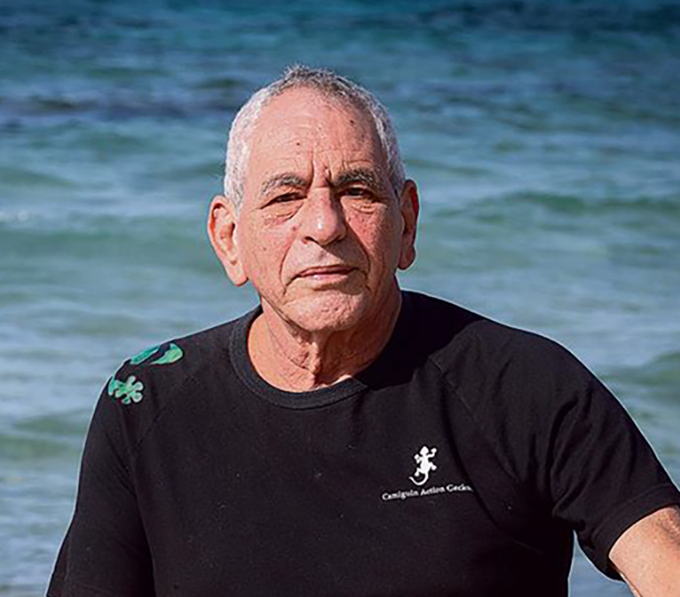
Arnos Gazit
La carriera artistica dell’israeliano Amos Gazit è iniziata in maniera casuale e del tutto inaspettata a seguito di una lunga riabilitazione dai danni provocati da serie ferite di guerra; il mare e principalmente il suo ambiente sottomarino, sono stati terapeutici per ritrovare lentamente la forza fisica e interiore per risalire da un periodo buio e complesso che avrebbe potuto lasciarlo a terra. Lui invece ha trovato un senso in quelle ferite così come nella capacità di risanarsi attraverso l’acqua e, con il tempo, anche con le immersioni subacquee che gli hanno permesso di scoprire quanto simile fosse l’atteggiamento innato del mare, capace di accogliere in sé oggetti e materiali non appartenenti alla fauna e alla flora sottomarina ma riuscendo a inglobarle e accoglierle come parte del suo meraviglioso paesaggio. Le lunghe passeggiate durante gli anni di riabilitazione, i dialoghi con le persone che vivono accanto al mare e grazie alle risorse che esso offre, e le immersioni alla scoperta delle meraviglie di quel mondo misterioso e affascinante dei fondali, hanno fatto nascere in lui non solo il desiderio di studiare e documentare l’ambiente marino ma anche aderire all’impegno e agli sforzi di organizzazioni internazionali per riabilitarlo dalla distruzione che la civiltà, più o meno consapevolmente o forse solo per superficiale distrazione, continua a causargli. I reportage subacquei di Amos Gazit si trasformano, in virtù del suo sguardo attento e sensibile, in vere e proprie opere d’arte, documenti importanti di quanta bellezza vi sia e quanti siano gli sforzi che quotidianamente compiono gli oceani e i mari per cercare di assorbire in sé elementi fuori luogo, persi dall’uomo, come relitti di barche, ancore, pezzi di metallo su cui cominciano a crescere elementi di flora marina, perché in fondo il mare accoglie e cerca di trasformare in bellezza ciò che in realtà sarebbe solo una disarmonia, una bruttura. Ed è forse in questo che Gazit ha sentito l’analogia con il suo percorso personale, le sue ferite, quelle che inconsciamente paragona alle stesse che vengono lasciate nel mare dall’azione dell’uomo, quel trovare un senso a tutto ciò che sembrerebbe non averne, come la guerra, le devastazioni osservate e le cicatrici, esteriori e interiori, che l’uomo, prima che l’artista, ha dovuto superare, non dimenticare questo no, ma riporre in un angolo della propria interiorità nella quale ha messo anche la consapevolezza che tutto ha fatto parte del suo cammino inducendolo a costruirsi un nuovo mondo espressivo, quello artistico. Sì perché nel caso degli scatti fotografici subacquei di Amos Gazit non si può non parlare di arte, la sua capacità di osservare e mettere in evidenza un solo dettaglio trasformandolo in frammento di un’opera d’arte è in grado di mostrare la bellezza insita nella natura che lui quotidianamente osserva e di trasportare l’osservatore in un mondo in cui tutto può essere altro rispetto a ciò che sembra.
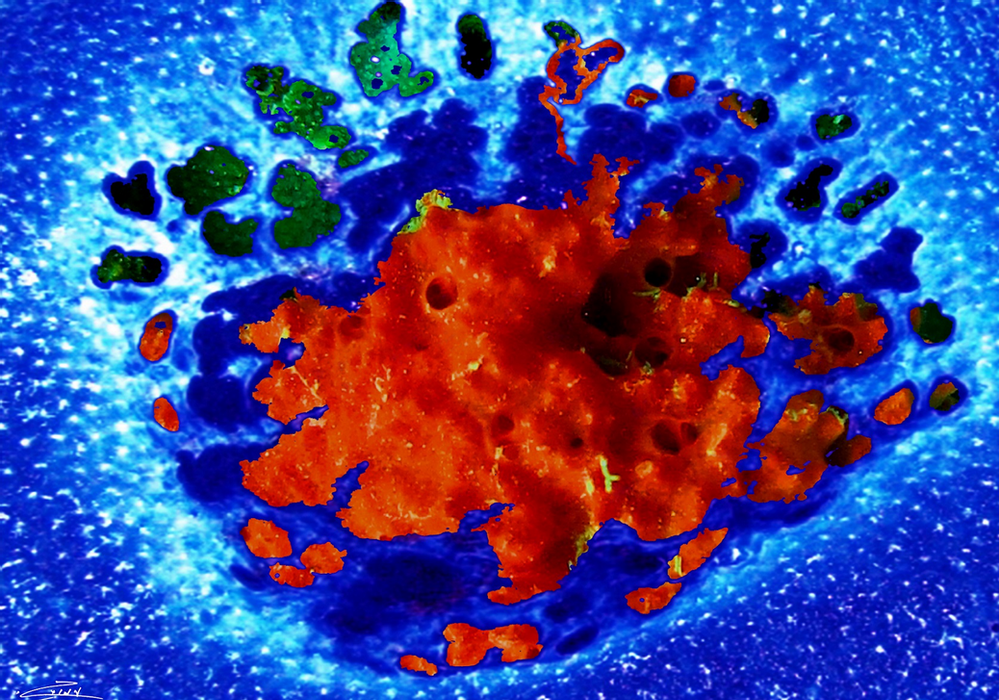
Coral abstract
In alcuni casi la meravigliosa flora marina diviene opera astratta mentre in altri Gazit ama mostrate quanto le specie invasive, quelle cioè portate dall’uomo, vengano trasformate dal mare come parte del suo paesaggio, inglobate e accettate.
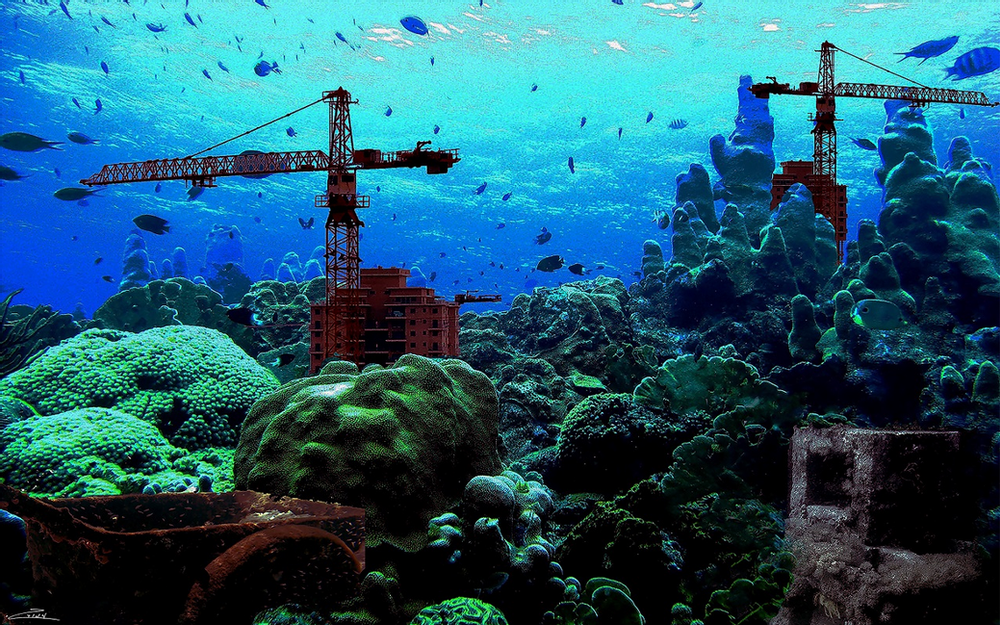
Invasion
Le fotografie dell’ambiente marino di Amos Gazit sono stampate su alluminio, vetro temperato, carta laminata, plexiglass, tela e rocce e sono esposte in gallerie, fanno parte di installazioni subacquee e incorporate in mobili e design di interni ed esterni. Ascoltiamo dalla viva voce di questo originale artista, il percorso che ha effettuato.
Lei si è trovato ad attraversare un momento molto difficile della sua vita, a seguito del quale ha trovato una nuova strada. Vuole raccontarci quanto è stato complesso rialzarsi e quanto sia stato importante l’impatto con il mondo marino?
All’età di 24 anni, in seguito al mio ultimo infortunio di guerra che ha complicato anche le mie ultime 2 ferite, così da giovane attivo e creativo – costruivo e creavo opere in ferro, amavo andare a cavallo, ballare e mettendo al mondo due splendide figlie a quell’epoca ancora piccole – mi sono ritrovato con il corpo mezzo paralizzato nel lato sinistro che è il mio lato dominante, camminando in modo difficoltoso e instabile, con la mano non funzionante, perdendo la memoria e la concentrazione e, cosa più inquietante, la mia pace della mente e dell’anima. Ho dovuto così affrontare una difficoltosa riabilitazione e ho cercato di lottare con tutti i limiti della mia nuova condizione. Come se tutto questo non fosse già sufficiente, ho subìto molti trattamenti medici sbagliati e distruttivi da parte dei dottori che non potevano ammettere i loro limiti e hanno causato ancora più danni. Tuttavia, non ero disposto a rinunciare e ho scoperto un dono che non sapevo di avere, quello cioè di poter essere un osservatore creativo e da quel momento ho cominciato a concentrarmi nel creare cose dove i miei limiti fisici non erano un ostacolo.
Solo anni dopo, all’età di 36 anni, ho scoperto il mare e ho intuito che in esso avrei ritrovato il silenzio, la capacità di muovermi e di fluire senza che i miei limiti fisici fossero un ostacolo; ho trovato il tempo per pensare, immaginare e creare liberamente, recuperando ciò che mi era mancato così tanto: la tranquillità e tutto ciò che porta con sé.
Poi, sono entrato in acqua e mi sono tuffato in questo magico mondo sottomarino.
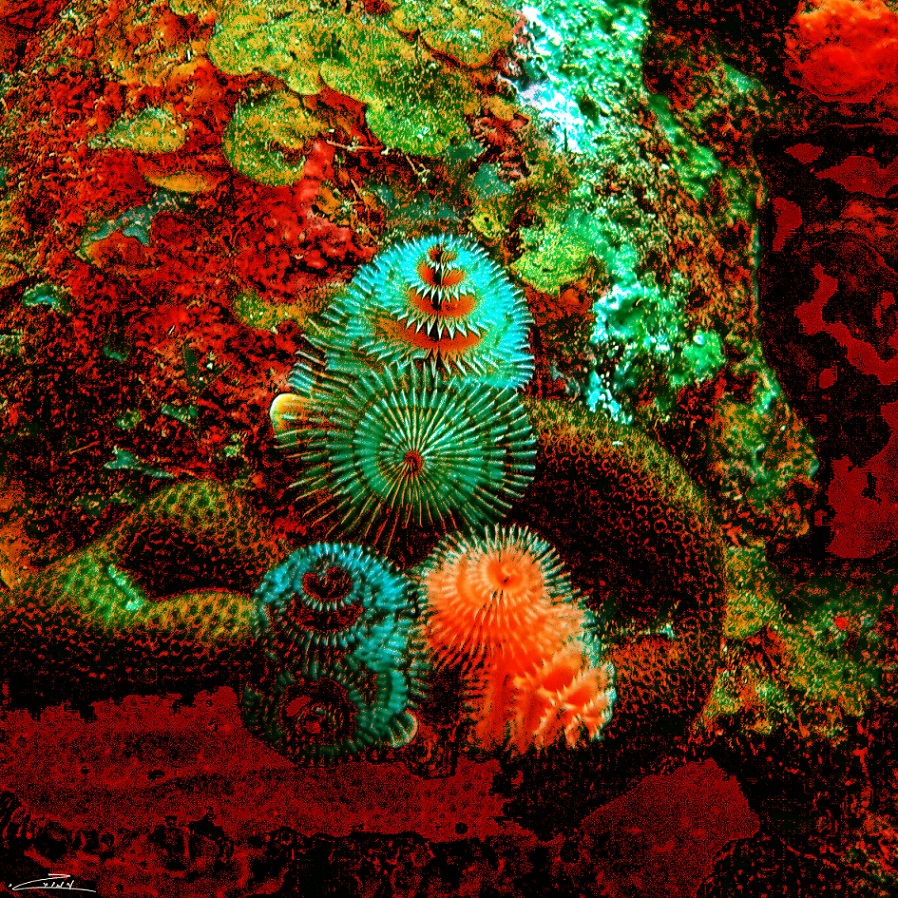
Sea scene
Qual è stato il momento in cui ha sentito che il desiderio di documentare i fondali e le sue bellezze avrebbe potuto trasformarsi in arte? C’è stato uno scatto in particolare che ha determinato l’inizio di questo suo nuovo percorso?
Una volta che il mare è diventato la mia nuova casa, il mio nuovo mondo desiderato, ho iniziato a conoscerlo, a comprendere la sua bellezza e cosa lo disturba perciò mi sono domandato come poter preservare e curare quei disturbi. E mentre lo osservavo, ho iniziato a documentare ciò che vedevo. La convivenza tra bellezza e bruttezza, in quest’ultimo caso principalmente artificiale, ha creato nella mia mente una miscela tempestosa che mi ha indotto a documentare tutto ciò che colpiva la mia attenzione, come se un diario, un racconto personale, intimo. Solo anni dopo quelle immagini sono state interpretate, da chi le vedeva, come forma d’arte; a quel punto ho cominciato a guardare i miei scatti con occhio diverso e, anche se non sono le prime che ho realizzato, ho identificato l’inizio del mio percorso artistico con l’immagine del riccio di mare sotto il tubo arrugginito, la foglia fluttuante e l’indigeno contro invasivo n. 1.
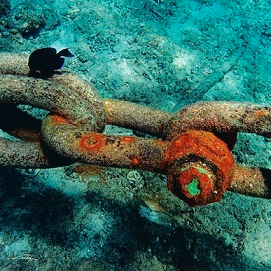
Invasive species
Lei è molto impegnato nelle campagne di tutela e salvaguardia dell’ambiente marino, ci racconta quali sono i progetti e le forze in campo per raggiungere l’obiettivo di purificare il mare e sensibilizzare le nazioni ad avere un approccio differente?
Il principale, e secondo il mio modesto parere, il modo migliore e più efficace è implementare progetti che combinino la creazione di installazioni sottomarine, realizzate solo con materiali naturali, come le rocce, vicino alla riva per creare riparo e attrarre la fauna e la flora del mare, che avranno anche la funzione di proteggere il litorale. Inoltre, l’integrazione di opere d’arte colorate di immagini subacquee, non solo renderà più efficiente l’attrazione della fauna marina, ma darà anche alle persone la possibilità di godere di visioni che non potrebbero vedere in alcun altro modo. Ciò aumenterà anche la consapevolezza delle persone di tutte le età sull’importanza e la bellezza dell’ambiente marino. Tuttavia, francamente ho davvero poca fiducia nella capacità della razza umana, soprattutto quando si tratta di autorità governative, di agire davvero di conseguenza, poiché in tali azioni entrano solitamente in campo molta arroganza e avidità.
Ha avviato una produzione di mobili e complementi d’arredo con i suoi scatti, quanto è importante lo spirito imprenditoriale per raggiungere questo obiettivo e commercializzare la sua arte? Ha avuto persone che hanno creduto nel suo progetto oppure è stato lei a diventare imprenditore di se stesso?
Lo spirito imprenditoriale è fondamentale per porsi e perseguire un obiettivo, tuttavia fino a oggi solo poche persone hanno acquistato alcuni tavoli e quadri di vetro per le loro piscine, e nonostante le reazioni molto positive di designer e architetti e il mio forte interesse a sviluppare il progetto, non ho ancora trovato il partner giusto per promuovere e sviluppare quello che credo veramente sia un enorme potenziale. Se tra i lettori di questa intervista c’è qualche imprenditore interessato sono disponibile a valutare idee e proposte.
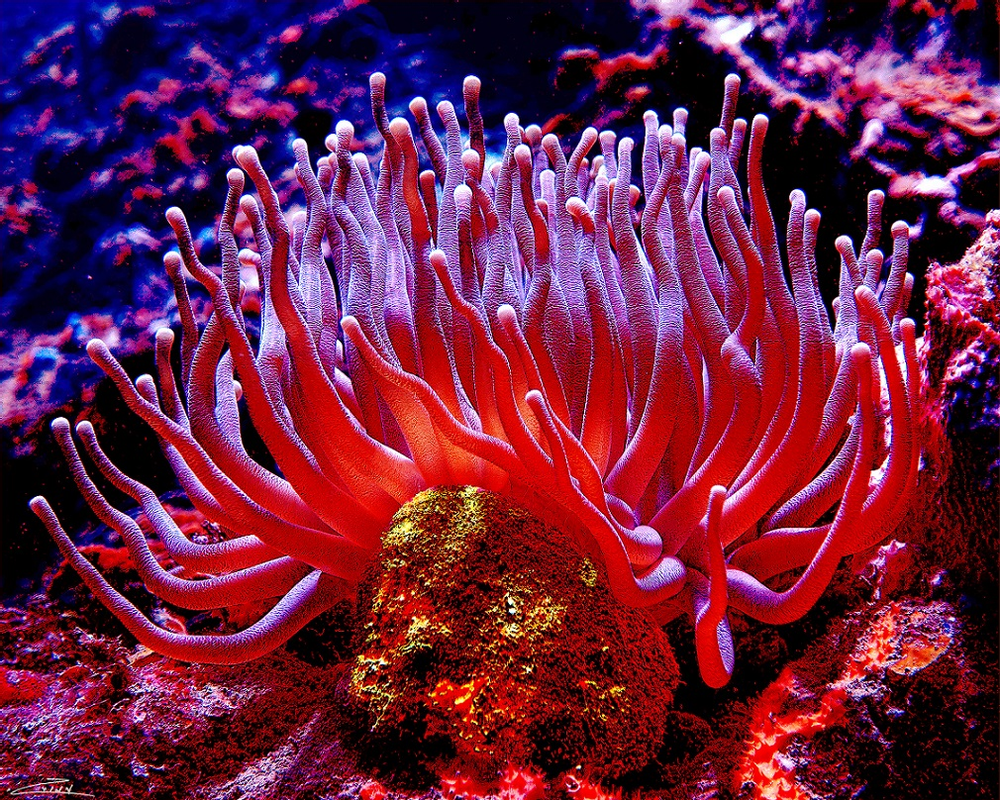
Deep inferno
Quali sono i prossimi programmi?
Oltre a continuare a presentare e vendere la mia produzione artistica in tutte le sue forme e la storia che c’è dietro, il mio desiderio più grande è quello di trovare lo sponsor per dar vita a un’istallazione permanente subacquea che unisca la mia esperienza professionale e la mia arte; la mia idea sarà utile non solo per sensibilizzare le persone nei confronti dell’ambiente ma servirà anche come centro dimostrativo e educativo.
AMOS GAZIT- CONTATTI
Email: amos@amosgazit.com
Sito web: www.amosgazit.com
Facebook: https://www.facebook.com/amos.gazit
Marta Lock’s interviews:
Amos Gazit, when the underwater world becomes an artwork
The artistic career of Israeli Amos Gazit began in a casual and totally unexpected way following a long rehabilitation from the damage caused by serious war wounds; the sea, and mainly its underwater environment were therapeutic to slowly find the physical and inner strength to recover from a dark and complex period that could have left him stranded. Instead, he found meaning in those wounds as well as in the ability to heal himself through water and, with time, also through scuba diving, which allowed him to discover how similar the innate attitude of the sea was, capable of welcoming in itself objects and materials that do not belong to the underwater fauna and flora, but managing to incorporate and welcome them as part of its wonderful landscape. His long walks during his years of rehabilitation, his dialogues with the people who live near the sea and thanks to the resources it offers, and his dives to discover the wonders of the mysterious and fascinating world of the seabed, gave him not only the desire to study and document the marine environment but also to join in the efforts of international organisations to rehabilitate it from the destruction that civilisation, more or less consciously or perhaps just through superficial distraction, continues to cause. Amos Gazit’s underwater reportages are transformed, thanks to his attentive and sensitive gaze, into true artworks, important documents of how much beauty there is and how much effort the oceans and seas make every day to try to absorb into themselves elements that are completely misplaced, left to man, concrete, plastics, fishing gear, such as shipwrecks, anchors, pieces of metal on which elements of marine flora are beginning to grow, because in the end the sea welcomes and tries to transform into beauty what in reality would only be disharmony, ugliness. And it is perhaps in this that Gazit has felt the analogy with his personal journey, his wounds, those that he unconsciously compares to the same wounds that are left in the sea by the action of man, that of finding meaning in everything that would seem to have none, such as war, the devastation observed and the scars, not to forget this, no, but to place it in a corner of his own interiority, where he has also placed the awareness that everything has been part of his journey, leading him to build a new expressive world, the artistic one. His ability to observe and highlight a single detail, transforming it into a fragment of an artwork, shows the beauty inherent in the nature he observes on a daily basis and transports the observer into a world where everything can be different from what it seems. In some cases the beautiful marine flora becomes an abstract work, while in others Gazit likes to show how invasive species, those brought by man, are transformed by the sea as part of its landscape, incorporated and accepted. Amos Gazit’s photographs of the marine environment are printed on printed on
tempered glass, canvas, aluminium, laminated paper, plexiglass, and rocks and are exhibited in galleries, are part of underwater installations and incorporated into furniture and interior and exterior design. Let’s hear from this original artist about the journey he has taken.
You went through a very difficult time in your life, after which you found a new path. Would you like to tell us how difficult it was to get up again and how important the impact with the marine world was?
At the age of 24, following my last war injury which also complicated my two previous wounds, so from an active and creative young man – I built and created iron works, loved horse riding, dancing and gave birth to two beautiful daughters who were still small at the time – I found myself with my body half-paralysed on my left side, which is my dominant side, walking with difficulty and instability, with my hand not working, losing my memory and concentration and, most worryingly, my peace of mind and soul. So I had to go through a difficult rehabilitation and tried to struggle with all the limitations of my new condition. As if all this was not enough, I suffered many wrong and destructive medical treatments from doctors who could not admit their limitations and caused even more damage. However, I wasn’t willing to give up and discovered a gift I didn’t know I had, which was that I could be a creative observer and from that moment on I began to concentrate on creating things where my physical limitations were not an obstacle.
It was only years later, at the age of 36, that I discovered the sea and realised that in it I would find silence, the ability to move and flow without my physical limitations being an obstacle; I found the time to think, imagine and create freely, recovering what I had missed so much: tranquillity and all that it brings with it. Then, I entered the water and dived into this magical underwater world.
What was the moment when you felt that the desire to document the seabed and its beauty could be turned into art? Was there a particular shot that determined the start of your new path?
Once the sea became my new home, my new desired world, I began to get to know it, to understand its beauty and what disturbs it so I wondered how I could preserve and cure those disturbances. And as I observed it, I began to document what I saw. The coexistence of beauty and ugliness, in the latter case mainly artificial, created a tempestuous mixture in my mind that led me to document everything that caught my eye, as if it were a diary, a personal, intimate account. It was only years later that those images were interpreted, by those who saw them, as an art form; at that point I began to look at my shots with a different eye and, even though they are not the first ones I have taken, I identified the beginning of my artistic journey with the image of the sea urchin under the rusty pipe, the floating leaf and the counter-invasive indigenous No. 1.
You are very involved in campaigns to protect and safeguard the marine environment. Can you tell us what projects and forces are at work to achieve the goal of purifying the sea and making nations aware of a different approach?
The main, and in my humble opinion, the best and most effective way is to implement projects that combine the creation of underwater installations, made only from natural materials, such as rocks, close to the shore to create shelter and attract the fauna and flora of the sea, which will also have the function of protecting the shoreline. In addition, the integration of colourful artworks of underwater images will not only make the attraction of marine fauna more efficient, but will also give people the opportunity to enjoy visions that they could not see in any other way or at all, as it extinct. This will also increase the awareness of people of all ages about the importance and beauty of the marine environment. However, frankly I have very little faith in the ability of the human race, especially when it comes to governmental authorities, to really act accordingly, as there is usually a lot of arrogance and greed involved in such actions.
You have started a production of furniture and furnishing accessories with your shots, how important is the entrepreneurial spirit to achieve this goal and market your art? Did you have people who believed in your project or did you become your own entrepreneur?
Entrepreneurial spirit is essential to set and pursue a goal, but until now only a few people have bought some glass tables and pictures for their pools, and despite the very positive reactions of designers and architects and my strong interest in developing the project, I have not yet found the right partner to promote and develop what I truly believe is a huge potential. If there are any interested entrepreneurs among the readers of this interview, I am available to evaluate ideas and proposals.
Which are your next plans?
Apart from continuing to present and sell my artistic production in all its forms and the story behind it, my greatest wish is to find the sponsor to create a permanent underwater installation combining my professional experience and my art; my idea will be useful not only to make people aware of the environment but will also serve as a demonstration and educational centre.
